The Intel Xeon W-3175X Review: 28 Unlocked Cores, $2999
by Ian Cutress on January 30, 2019 9:00 AM ESTCPU Performance: Office Tests
The Office test suite is designed to focus around more industry standard tests that focus on office workflows, system meetings, some synthetics, but we also bundle compiler performance in with this section. For users that have to evaluate hardware in general, these are usually the benchmarks that most consider.
All of our benchmark results can also be found in our benchmark engine, Bench.
For our graphs, some of them have two values: a regular value in orange, and one in red called 'Intel Spec'. ASUS offers the option to 'open up' the power and current limits of the chip, so the CPU is still running at the same frequency but is not throttled. Despite Intel saying that they recommend 'Intel Spec', the system they sent to us to test was actually set up with the power limits opened up, and the results they provided for us to compare to internally also correlated with that setting. As a result, we're providing both sets results for our CPU tests.
PCMark 10: Industry Standard System Profiler
Futuremark, now known as UL, has developed benchmarks that have become industry standards for around two decades. The latest complete system test suite is PCMark 10, upgrading over PCMark 8 with updated tests and more OpenCL invested into use cases such as video streaming.
PCMark splits its scores into about 14 different areas, including application startup, web, spreadsheets, photo editing, rendering, video conferencing, and physics. We post all of these numbers in our benchmark database, Bench, however the key metric for the review is the overall score.
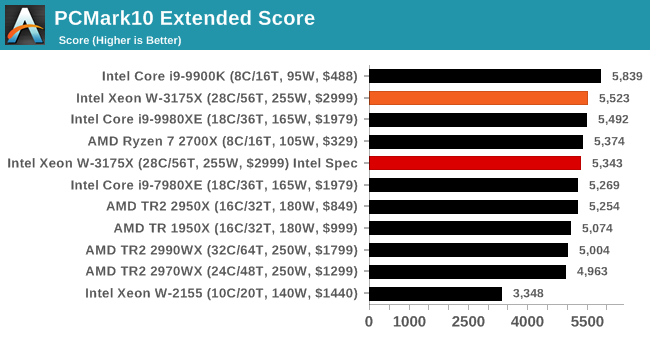
.
Chromium Compile: Windows VC++ Compile of Chrome 56
A large number of AnandTech readers are software engineers, looking at how the hardware they use performs. While compiling a Linux kernel is ‘standard’ for the reviewers who often compile, our test is a little more varied – we are using the windows instructions to compile Chrome, specifically a Chrome 56 build from March 2017, as that was when we built the test. Google quite handily gives instructions on how to compile with Windows, along with a 400k file download for the repo.
In our test, using Google’s instructions, we use the MSVC compiler and ninja developer tools to manage the compile. As you may expect, the benchmark is variably threaded, with a mix of DRAM requirements that benefit from faster caches. Data procured in our test is the time taken for the compile, which we convert into compiles per day.
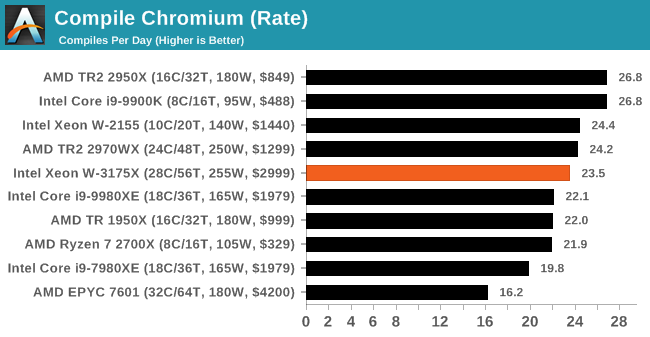
.
3DMark Physics: In-Game Physics Compute
Alongside PCMark is 3DMark, Futuremark’s (UL’s) gaming test suite. Each gaming tests consists of one or two GPU heavy scenes, along with a physics test that is indicative of when the test was written and the platform it is aimed at. The main overriding tests, in order of complexity, are Ice Storm, Cloud Gate, Sky Diver, Fire Strike, and Time Spy.
Some of the subtests offer variants, such as Ice Storm Unlimited, which is aimed at mobile platforms with an off-screen rendering, or Fire Strike Ultra which is aimed at high-end 4K systems with lots of the added features turned on. Time Spy also currently has an AVX-512 mode (which we may be using in the future).
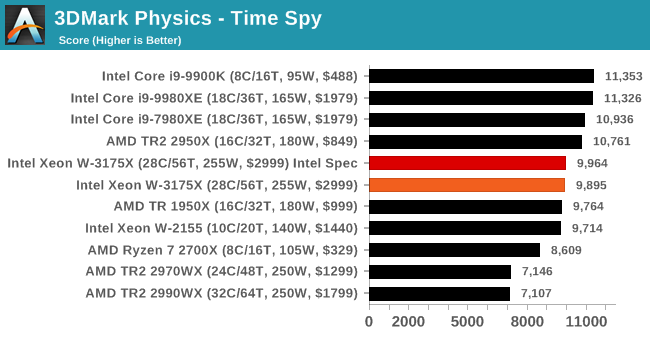
.
GeekBench4: Synthetics
A common tool for cross-platform testing between mobile, PC, and Mac, GeekBench 4 is an ultimate exercise in synthetic testing across a range of algorithms looking for peak throughput. Tests include encryption, compression, fast Fourier transform, memory operations, n-body physics, matrix operations, histogram manipulation, and HTML parsing.
I’m including this test due to popular demand, although the results do come across as overly synthetic, and a lot of users often put a lot of weight behind the test due to the fact that it is compiled across different platforms (although with different compilers).
We record the main subtest scores (Crypto, Integer, Floating Point, Memory) in our benchmark database, but for the review we post the overall single and multi-threaded results.
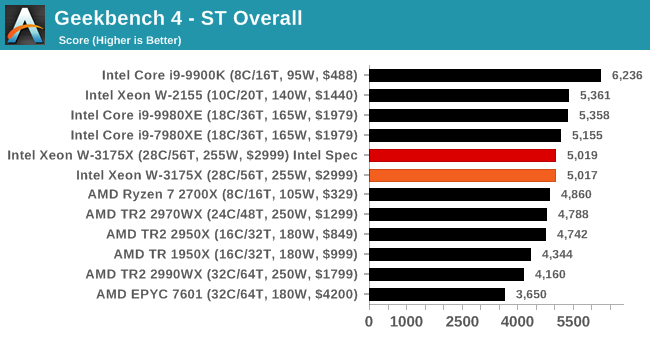
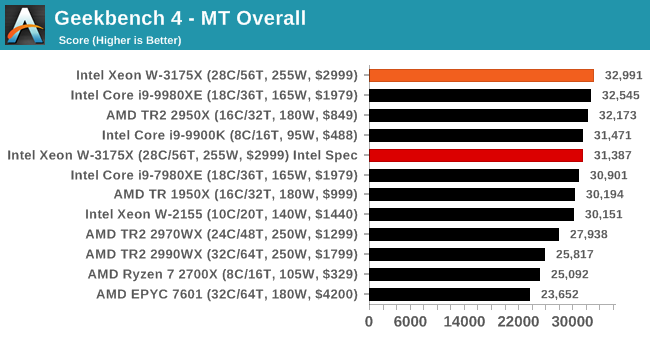










136 Comments
View All Comments
johngardner58 - Monday, February 24, 2020 - link
Again it depends on the need. If you need speed, there is no alternative. You can't get it by just running blades because not everything can be broken apart into independent parallel processes. Our company once ran an analysis that took a very long time. When time is money this is the only thing that will fill the bill for certain workloads. Having shared high speed resources (memory and cache) make the difference. That is why 255 Raspberry PIs clustered will not outperform most home desktops unless they are doing highly independent parallel processes. Actually the MIPS per watt on such a processor is probably lower than having individual processors because of the combined inefficiencies of duplicate support circuitry.SanX - Friday, February 1, 2019 - link
Every second home has few running space heaters 1500W at winter timejohngardner58 - Monday, February 24, 2020 - link
Server side: depends on workload, usually yes a bladed or multiprocessor setup is usually better for massively parallel (independent) tasks, but cores can talk to each other much much much faster than blades, as they share caches, memory. So for less parallel work loads (single process multiple threads: e.g. rendering, numerics & analytics) this can provide far more performance and reduced costs. Probably the best example of the need for core count is GPU based processing. Intel also had specialized high core count XEON based accelerator cards with 96 cores at one point. There is a need even if limited.Samus - Thursday, January 31, 2019 - link
The problem is in the vast majority of the applications an $1800 CPU from AMD running on a $300 motherboard (that's an overall platform savings of $2400!) the AMD CPU either matches or beats the Intel Xeon. You have to cherry-pick the benchmarks Intel leads in, and yes, it leads by a healthy margin, but they basically come down to 7-zip, random rendering tasks, and Corona.Disaster strikes when you consider there is ZERO headroom for overclocking the Intel Xeon, where the AMD Threadripper has some headroom to probably narrow the gap on these few and far between defeats.
I love Intel but wow what the hell has been going on over there lately...
Jimbo2K7 - Wednesday, January 30, 2019 - link
Baby's on fire? Better throw her in the water!Love the Eno reference!
repoman27 - Wednesday, January 30, 2019 - link
Nah, I figure Ian for more of a Die Antwoord fan. Intel’s gone zef style to compete with AMD’s Zen style.Ian Cutress - Wednesday, January 30, 2019 - link
^ repoman gets it. I actually listen mostly to melodic/death metal and industrial. Something fast paced to help overclock my brainWasHopingForAnHonestReview - Wednesday, January 30, 2019 - link
My manIGTrading - Wednesday, January 30, 2019 - link
Was testing done with mediation regarding the specific windows BUG that affects AMD's CPUs with more than 16 cores? Or was it done with no attempt to ensure normal processing conditions for ThreadRipper, despite the known bug?eva02langley - Thursday, January 31, 2019 - link
Insomnium, Kalmah, Hypocrisy, Dark Tranquility, Ne Obliviscaris...By the way, Saor and Rotting Christ are releasing their albums in two weeks.
You might want to check out Carpenter Brut - Leether Teeths and Rivers of Nihil - Where Owls Know My Name.